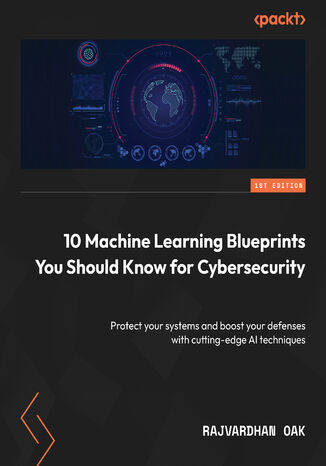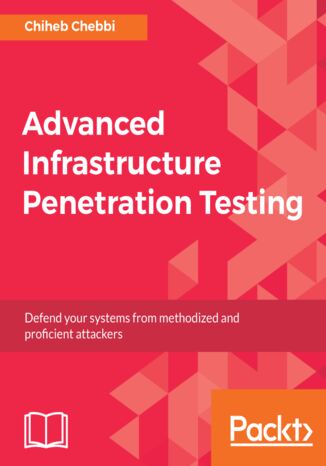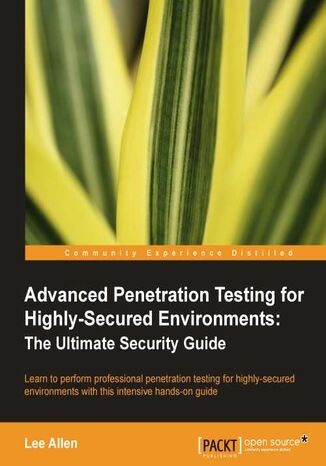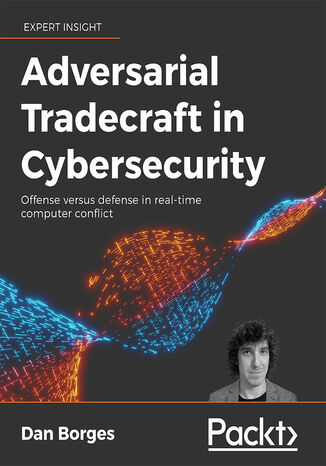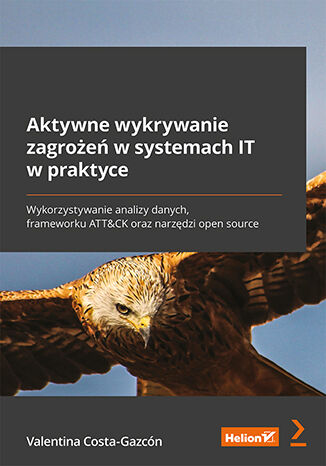Kategorie
Ebooki
-
Biznes i ekonomia
- Bitcoin
- Bizneswoman
- Coaching
- Controlling
- E-biznes
- Ekonomia
- Finanse
- Giełda i inwestycje
- Kompetencje osobiste
- Komputer w biurze
- Komunikacja i negocjacje
- Mała firma
- Marketing
- Motywacja
- Multimedialne szkolenia
- Nieruchomości
- Perswazja i NLP
- Podatki
- Polityka społeczna
- Poradniki
- Prezentacje
- Przywództwo
- Public Relation
- Raporty, analizy
- Sekret
- Social Media
- Sprzedaż
- Start-up
- Twoja kariera
- Zarządzanie
- Zarządzanie projektami
- Zasoby ludzkie (HR)
-
Dla dzieci
-
Dla młodzieży
-
Edukacja
-
Encyklopedie, słowniki
-
E-prasa
- Architektura i wnętrza
- Biznes i Ekonomia
- Dom i ogród
- E-Biznes
- Finanse
- Finanse osobiste
- Firma
- Fotografia
- Informatyka
- Kadry i płace
- Komputery, Excel
- Księgowość
- Kultura i literatura
- Naukowe i akademickie
- Ochrona środowiska
- Opiniotwórcze
- Oświata
- Podatki
- Podróże
- Psychologia
- Religia
- Rolnictwo
- Rynek książki i prasy
- Transport i Spedycja
- Zdrowie i uroda
-
Historia
-
Informatyka
- Aplikacje biurowe
- Bazy danych
- Bioinformatyka
- Biznes IT
- CAD/CAM
- Digital Lifestyle
- DTP
- Elektronika
- Fotografia cyfrowa
- Grafika komputerowa
- Gry
- Hacking
- Hardware
- IT w ekonomii
- Pakiety naukowe
- Podręczniki szkolne
- Podstawy komputera
- Programowanie
- Programowanie mobilne
- Serwery internetowe
- Sieci komputerowe
- Start-up
- Systemy operacyjne
- Sztuczna inteligencja
- Technologia dla dzieci
- Webmasterstwo
-
Inne
-
Języki obce
-
Kultura i sztuka
-
Lektury szkolne
-
Literatura
- Antologie
- Ballada
- Biografie i autobiografie
- Dla dorosłych
- Dramat
- Dzienniki, pamiętniki, listy
- Epos, epopeja
- Esej
- Fantastyka i science-fiction
- Felietony
- Fikcja
- Humor, satyra
- Inne
- Klasyczna
- Kryminał
- Literatura faktu
- Literatura piękna
- Mity i legendy
- Nobliści
- Nowele
- Obyczajowa
- Okultyzm i magia
- Opowiadania
- Pamiętniki
- Podróże
- Poemat
- Poezja
- Polityka
- Popularnonaukowa
- Powieść
- Powieść historyczna
- Proza
- Przygodowa
- Publicystyka
- Reportaż
- Romans i literatura obyczajowa
- Sensacja
- Thriller, Horror
- Wywiady i wspomnienia
-
Nauki przyrodnicze
-
Nauki społeczne
-
Podręczniki szkolne
-
Popularnonaukowe i akademickie
- Archeologia
- Bibliotekoznawstwo
- Filmoznawstwo
- Filologia
- Filologia polska
- Filozofia
- Finanse i bankowość
- Geografia
- Gospodarka
- Handel. Gospodarka światowa
- Historia i archeologia
- Historia sztuki i architektury
- Kulturoznawstwo
- Lingwistyka
- Literaturoznawstwo
- Logistyka
- Matematyka
- Medycyna
- Nauki humanistyczne
- Pedagogika
- Pomoce naukowe
- Popularnonaukowa
- Pozostałe
- Psychologia
- Socjologia
- Teatrologia
- Teologia
- Teorie i nauki ekonomiczne
- Transport i spedycja
- Wychowanie fizyczne
- Zarządzanie i marketing
-
Poradniki
-
Poradniki do gier
-
Poradniki zawodowe i specjalistyczne
-
Prawo
- BHP
- Historia
- Kodeks drogowy. Prawo jazdy
- Nauki prawne
- Ochrona zdrowia
- Ogólne, kompendium wiedzy
- Podręczniki akademickie
- Pozostałe
- Prawo budowlane i lokalowe
- Prawo cywilne
- Prawo finansowe
- Prawo gospodarcze
- Prawo gospodarcze i handlowe
- Prawo karne
- Prawo karne. Przestępstwa karne. Kryminologia
- Prawo międzynarodowe
- Prawo międzynarodowe i zagraniczne
- Prawo ochrony zdrowia
- Prawo oświatowe
- Prawo podatkowe
- Prawo pracy i ubezpieczeń społecznych
- Prawo publiczne, konstytucyjne i administracyjne
- Prawo rodzinne i opiekuńcze
- Prawo rolne
- Prawo socjalne, prawo pracy
- Prawo Unii Europejskiej
- Przemysł
- Rolne i ochrona środowiska
- Słowniki i encyklopedie
- Zamówienia publiczne
- Zarządzanie
-
Przewodniki i podróże
- Afryka
- Albumy
- Ameryka Południowa
- Ameryka Środkowa i Północna
- Australia, Nowa Zelandia, Oceania
- Austria
- Azja
- Bałkany
- Bliski Wschód
- Bułgaria
- Chiny
- Chorwacja
- Czechy
- Dania
- Egipt
- Europa
- Francja
- Góry
- Grecja
- Hiszpania
- Holandia
- Islandia
- Litwa
- Mapy, Plany miast, Atlasy
- Miniprzewodniki
- Niemcy
- Norwegia
- Podróże aktywne
- Polska
- Portugalia
- Pozostałe
- Rosja
- Rumunia
- Słowacja
- Słowenia
- Szwajcaria
- Szwecja
- Świat
- Turcja
- Ukraina
- Węgry
- Wielka Brytania
- Włochy
-
Psychologia
- Filozofie życiowe
- Kompetencje psychospołeczne
- Komunikacja międzyludzka
- Mindfulness
- Ogólne
- Perswazja i NLP
- Psychologia akademicka
- Psychologia duszy i umysłu
- Psychologia pracy
- Relacje i związki
- Rodzicielstwo i psychologia dziecka
- Rozwiązywanie problemów
- Rozwój intelektualny
- Sekret
- Seksualność
- Uwodzenie
- Wygląd i wizerunek
- Życiowe filozofie
-
Religia
-
Sport, fitness, diety
-
Technika i mechanika
Audiobooki
-
Biznes i ekonomia
- Bitcoin
- Bizneswoman
- Coaching
- Controlling
- E-biznes
- Ekonomia
- Finanse
- Giełda i inwestycje
- Kompetencje osobiste
- Komunikacja i negocjacje
- Mała firma
- Marketing
- Motywacja
- Nieruchomości
- Perswazja i NLP
- Podatki
- Poradniki
- Prezentacje
- Przywództwo
- Public Relation
- Sekret
- Social Media
- Sprzedaż
- Start-up
- Twoja kariera
- Zarządzanie
- Zarządzanie projektami
- Zasoby ludzkie (HR)
-
Dla dzieci
-
Dla młodzieży
-
Edukacja
-
Encyklopedie, słowniki
-
Historia
-
Informatyka
-
Inne
-
Języki obce
-
Kultura i sztuka
-
Lektury szkolne
-
Literatura
- Antologie
- Ballada
- Biografie i autobiografie
- Dla dorosłych
- Dramat
- Dzienniki, pamiętniki, listy
- Epos, epopeja
- Esej
- Fantastyka i science-fiction
- Felietony
- Fikcja
- Humor, satyra
- Inne
- Klasyczna
- Kryminał
- Literatura faktu
- Literatura piękna
- Mity i legendy
- Nobliści
- Nowele
- Obyczajowa
- Okultyzm i magia
- Opowiadania
- Pamiętniki
- Podróże
- Poezja
- Polityka
- Popularnonaukowa
- Powieść
- Powieść historyczna
- Proza
- Przygodowa
- Publicystyka
- Reportaż
- Romans i literatura obyczajowa
- Sensacja
- Thriller, Horror
- Wywiady i wspomnienia
-
Nauki przyrodnicze
-
Nauki społeczne
-
Popularnonaukowe i akademickie
-
Poradniki
-
Poradniki zawodowe i specjalistyczne
-
Prawo
-
Przewodniki i podróże
-
Psychologia
- Filozofie życiowe
- Komunikacja międzyludzka
- Mindfulness
- Ogólne
- Perswazja i NLP
- Psychologia akademicka
- Psychologia duszy i umysłu
- Psychologia pracy
- Relacje i związki
- Rodzicielstwo i psychologia dziecka
- Rozwiązywanie problemów
- Rozwój intelektualny
- Sekret
- Seksualność
- Uwodzenie
- Wygląd i wizerunek
- Życiowe filozofie
-
Religia
-
Sport, fitness, diety
-
Technika i mechanika
Kursy video
-
Bazy danych
-
Big Data
-
Biznes i ekonomia
-
Cyberbezpieczeństwo
-
Data Science
-
DevOps
-
Dla dzieci
-
Elektronika
-
Grafika/Wideo/CAX
-
Gry
-
Microsoft Office
-
Narzędzia programistyczne
-
Programowanie
-
Rozwój osobisty
-
Sieci komputerowe
-
Systemy operacyjne
-
Testowanie oprogramowania
-
Urządzenia mobilne
-
UX/UI
-
Web development
Podcasty
Bezpieczeństwo sieci
Machine learning in security is harder than other domains because of the changing nature and abilities of adversaries, high stakes, and a lack of ground-truth data. This book will prepare machine learning practitioners to effectively handle tasks in the challenging yet exciting cybersecurity space.The book begins by helping you understand how advanced ML algorithms work and shows you practical examples of how they can be applied to security-specific problems with Python – by using open source datasets or instructing you to create your own. In one exercise, you’ll also use GPT 3.5, the secret sauce behind ChatGPT, to generate an artificial dataset of fabricated news. Later, you’ll find out how to apply the expert knowledge and human-in-the-loop decision-making that is necessary in the cybersecurity space. This book is designed to address the lack of proper resources available for individuals interested in transitioning into a data scientist role in cybersecurity. It concludes with case studies, interview questions, and blueprints for four projects that you can use to enhance your portfolio.By the end of this book, you’ll be able to apply machine learning algorithms to detect malware, fake news, deep fakes, and more, along with implementing privacy-preserving machine learning techniques such as differentially private ML.
125 sposobów na bezpieczeństwo sieci. Wydanie II
Praktyczny przewodnik po technikach zabezpieczania sieci komputerowych Jak sprawnie zabezpieczyć system? Jak zapewnić sobie prywatność w internecie? Jak skutecznie walczyć z sieciowymi włamywaczami? W naszych domach montujemy solidne zamki i drzwi, chronimy samochody wymyślnymi alarmami, w firmach zakładamy systemy monitoringu, jednak nadal wiele osób nie zwraca wystarczającej uwagi na bezpieczeństwo komputerów w sieciach domowych oraz korporacyjnych. Luki w systemach informatycznych powodują każdego roku straty rzędu miliardów dolarów, a przecież dostępnych jest wiele narzędzi i technik, które pozwalają skutecznie zabezpieczyć komputery przed atakami crackerów. "125 sposobów na bezpieczeństwo w sieci. Wydanie II" to zaktualizowany i rozbudowany zbiór praktycznych porad dotyczących zabezpieczania systemów informatycznych przed atakami. Dzięki wskazówkom przygotowanym przez cenionych profesjonalistów dowiesz się, jak stosować najnowsze narzędzia systemowe i niezależne programy do zabezpieczania systemów i danych, ochrony własnej prywatności w sieci czy bezpiecznego łączenia zdalnych maszyn. Nauczysz się także zastawiać pułapki na sieciowych napastników, wykrywać ich obecność w sieci i szybko przywracać normalne funkcjonowanie systemu po ewentualnym ataku. Zabezpieczanie systemów Windows i uniksowych Zapewnianie prywatności w internecie Konfigurowanie i testowanie zapór sieciowych Bezpieczne korzystanie z usług Zabezpieczanie sieci przewodowych i bezprzewodowych Monitorowanie działania sieci Stosowanie silnego szyfrowania i uwierzytelniania Wykrywanie włamań i przywracanie działania sieci Stosuj sprawdzone sposoby zapewniania bezpieczeństwa w sieci.
It has always been difficult to gain hands-on experience and a comprehensive understanding of advanced penetration testing techniques and vulnerability assessment and management. This book will be your one-stop solution to compromising complex network devices and modern operating systems. This book provides you with advanced penetration testing techniques that will help you exploit databases, web and application servers, switches or routers, Docker, VLAN, VoIP, and VPN.With this book, you will explore exploitation abilities such as offensive PowerShell tools and techniques, CI servers, database exploitation, Active Directory delegation, kernel exploits, cron jobs, VLAN hopping, and Docker breakouts. Moving on, this book will not only walk you through managing vulnerabilities, but will also teach you how to ensure endpoint protection. Toward the end of this book, you will also discover post-exploitation tips, tools, and methodologies to help your organization build an intelligent security system.By the end of this book, you will have mastered the skills and methodologies needed to breach infrastructures and provide complete endpoint protection for your system.
Network simulation is a powerful technique that uses software programs to replicate the behaviors of real networks. Network simulators are programs that can predict the performance of computer networks or wireless communication networks. This book is your hands-on guide to ns-3, a script-based simulator that allows for learning, experimenting, and evaluating wired, wireless (802.11a/b/g/n/ac/ax), and 4G long-term evolution (LTE) networks quickly and at low cost.You’ll begin by learning how to install and use ns-3, along with exploring its key features such as building blocks for creating a variety of wired or wireless network topologies, installing suitable protocols and applications, identifying and resolving networking issues, and systematically evaluating network performance. As you make progress, you’ll gain a clear understanding of simulation errors, exceptions, and abrupt events. You’ll also discover how to set up and evaluate Ethernet, Wi-Fi (802.11n/ac/ax) LANs, ad-hoc, and LTE networks. The concluding chapters discuss LTE advanced topics such as capacity planning, site surveys, radio resources, mobility management, and interference handling. By the end of this simulation book, you’ll be able to use ns-3 to implement, analyze, debug, and evaluate the performance of wired or wireless networks, as well as setting up custom test scenarios.
The internet security field has grown by leaps and bounds over the last decade. Everyday more people around the globe gain access to the internet and not all of them with good intentions. The need for penetration testers has grown now that the security industryhas had time to mature. Simply running a vulnerability scanner is a thing of the past and is no longer an effective method of determining a business's true security posture. Learn effective penetration testing skills so that you can effectively meet and manage the rapidly changing security needs of your company. Advanced Penetration Testing for Highly-Secured Environments will teach you how to efficiently and effectively ensure the security posture of environments that have been secured using IDS/IPS, firewalls, network segmentation, hardened system configurations and more. The stages of a penetration test are clearly defined and addressed using step-by-step instructions that you can follow on your own virtual lab.The book follows the standard penetration testing stages from start to finish with step-by-step examples. The book thoroughly covers penetration test expectations, proper scoping and planning, as well as enumeration and footprinting. You'll learn how to clean up and compile proof of concept, exploit code from the web, advanced web application testing techniques, client side attacks, post exploitation strategies, detection avoidance methods, generation of well defined reports and metrics, and setting up a penetration testing virtual lab that mimics a secured environment. The book closes by issuing a challenge to your skills and ability to perform a full penetration test against a fictional corporation; followed by a detailed walk through of the solution.Advanced Penetration Testing for Highly-Secured Environments is packed with detailed examples that reinforce enumeration, exploitation, post-exploitation, reporting skills and more.
Adversarial Tradecraft in Cybersecurity. Offense versus defense in real-time computer conflict
Little has been written about what to do when live hackers are on your system and running amok. Even experienced hackers tend to choke up when they realize the network defender has caught them and is zoning in on their implants in real time. This book will provide tips and tricks all along the kill chain of an attack, showing where hackers can have the upper hand in a live conflict and how defenders can outsmart them in this adversarial game of computer cat and mouse.This book contains two subsections in each chapter, specifically focusing on the offensive and defensive teams. It begins by introducing you to adversarial operations and principles of computer conflict where you will explore the core principles of deception, humanity, economy, and more about human-on-human conflicts. Additionally, you will understand everything from planning to setting up infrastructure and tooling that both sides should have in place.Throughout this book, you will learn how to gain an advantage over opponents by disappearing from what they can detect. You will further understand how to blend in, uncover other actors’ motivations and means, and learn to tamper with them to hinder their ability to detect your presence. Finally, you will learn how to gain an advantage through advanced research and thoughtfully concluding an operation.By the end of this book, you will have achieved a solid understanding of cyberattacks from both an attacker’s and a defender’s perspective.
Udany atak na system informatyczny organizacji może mieć bardzo poważne konsekwencje. W ostatnich latach analitycy cyberbezpieczeństwa starają się uprzedzać zagrożenia i je neutralizować, zanim dojdzie do wystąpienia większych szkód w systemie. Podejście to wymaga nieustannego testowania i wzmacniania mechanizmów obronnych w systemie informatycznym organizacji. W ramach tych procesów można zebrać wiele cennych danych, użyć ich do budowy modeli i dzięki temu lepiej zrozumieć istotne kwestie związane z bezpieczeństwem IT. Ta książka to praktyczny przewodnik po aktywnych technikach wykrywania, analizowania i neutralizowania zagrożeń cybernetycznych. Dzięki niej, nawet jeśli nie posiadasz specjalistycznej wiedzy w tym zakresie, łatwo wdrożysz od podstaw skuteczny program aktywnego zabezpieczania swojej organizacji. Dowiesz się, w jaki sposób wykrywać ataki, jak zbierać dane i za pomocą modeli pozyskiwać z nich cenne informacje. Przekonasz się, że niezbędne środowisko możesz skonfigurować przy użyciu narzędzi open source. Dzięki licznym ćwiczeniom nauczysz się w praktyce korzystać z biblioteki testów Atomic Red Team, a także z frameworku MITRE ATT&CK™. Ponadto zdobędziesz umiejętności związane z dokumentowaniem swoich działań, definiowaniem wskaźników bezpieczeństwa systemu, jak również komunikowaniem informacji o jego naruszeniach swoim współpracownikom, przełożonym i partnerom biznesowym. Dzięki książce: poznasz podstawy informatyki śledczej i analizy zagrożeń dowiesz się, w jaki sposób modelować zebrane dane i dokumentować wyniki badań nauczysz się symulować działania agresorów w środowisku laboratoryjnym wprawisz się we wczesnym wykrywaniu naruszeń poznasz zasady komunikowania się z kierownictwem i otoczeniem biznesowym To proste. Szukaj. Wykryj. Zneutralizuj!

